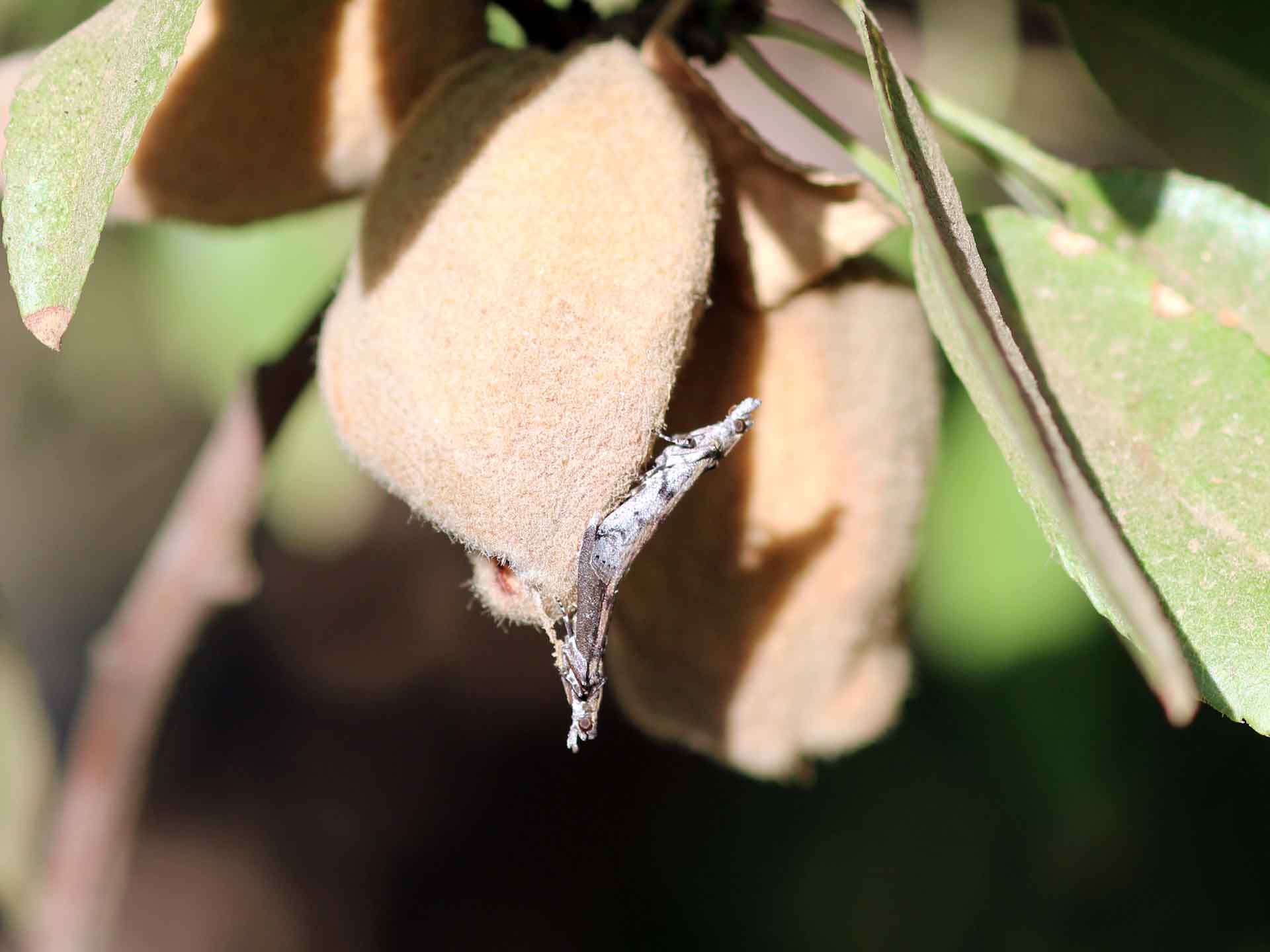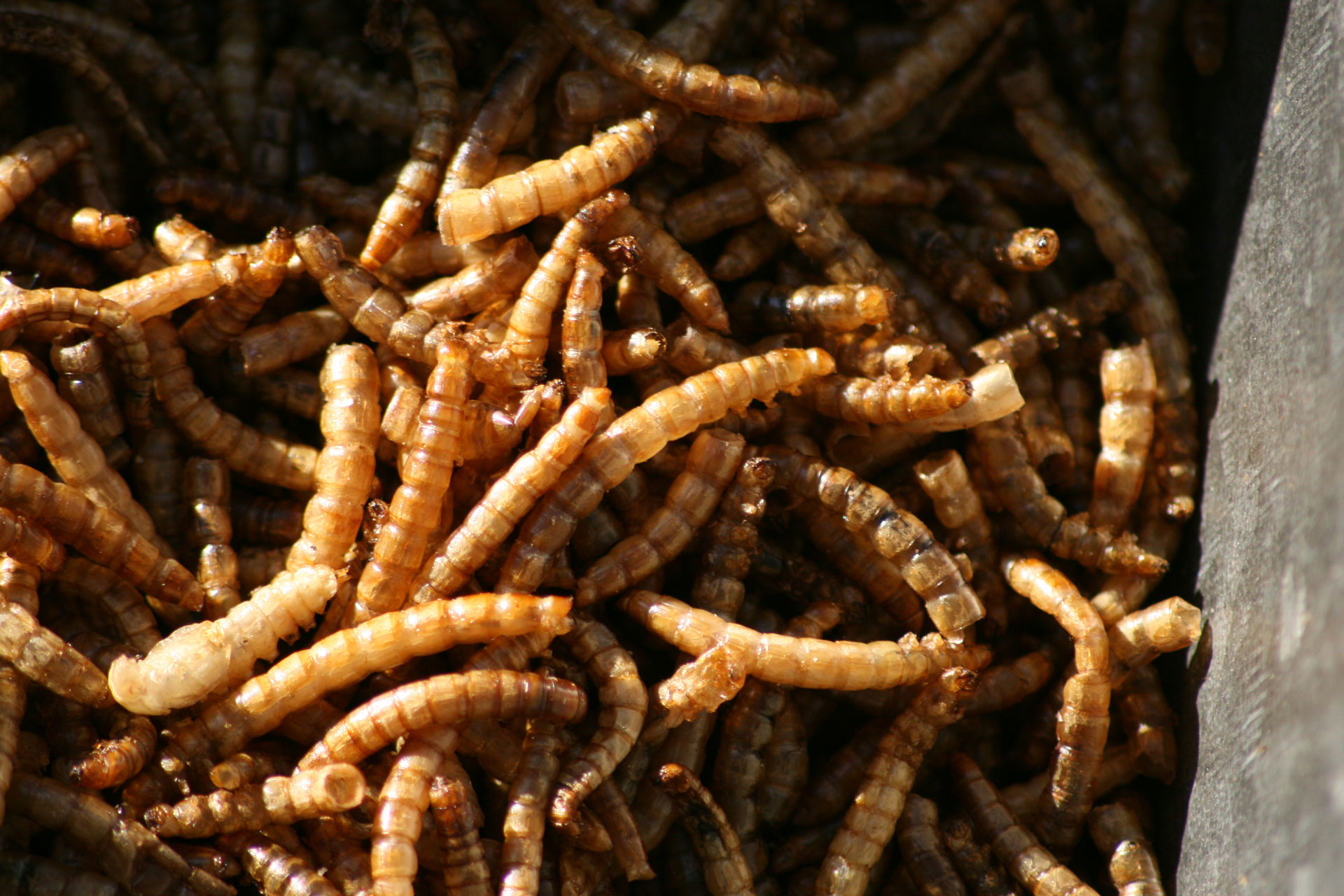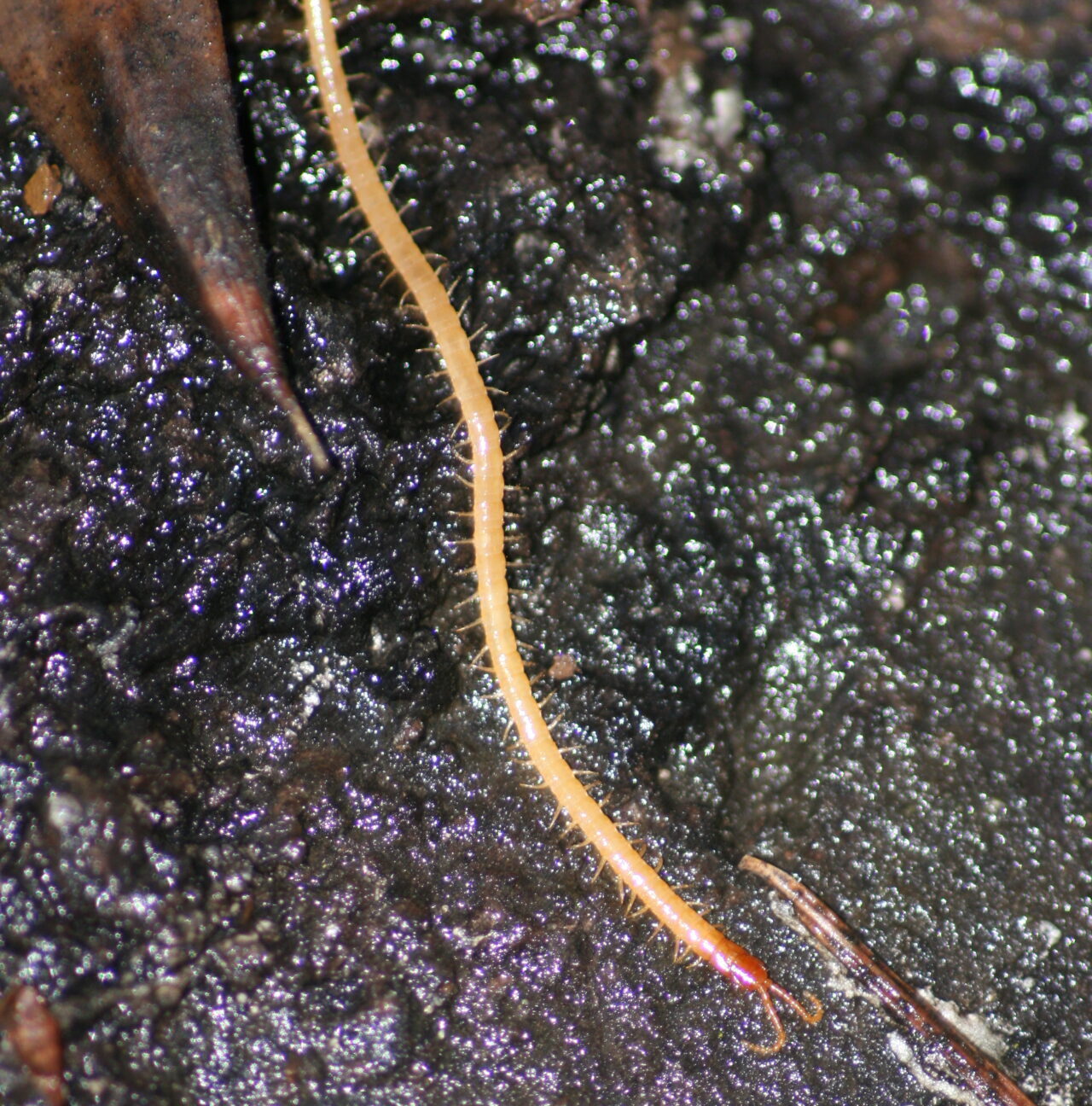Effective management of navel orangeworm requires an integrated approach to pest management. This is especially true in organic nut crops where insecticides that are industry standards in convention orchards are not available. This puts added emphasis on the need for variety selection, winter sanitation, timely harvest, and mating disruption.
Mating Disruption
Mating disruption works by using dispensers to flood an orchard with synthetically-produced pheromone, thus interrupting the ability of male moths to find and mate with females. Reductions in eggs and larvae occur if females fail to mate or if there is a delay in when mating occurs.
There are currently two mating disruption products registered for use in organic nut crops in California. The first is Cidetrak NOW Meso from Trécé. The ‘Meso’ dispenser looks like a foot-long strip of rubber that releases pheromone passively throughout the season. The emitters are typically hung in the orchard at a rate of 20 per acre, with the label allowing a range of 15 to 28. Dispensers are hung in the orchard prior to moth emergence in the spring. Pheromone is released throughout the season for approximately 150 to 180 days and there is no need to recover the emitters at the end of the season.
The second product is called Semios NOW Eco from Semios. This product releases pheromone from pressurized aerosol canisters contained within dispensers. The dispensers are placed in the tree at a rate of 1 per acre prior to moth emergence in the spring. The standard rate for pheromone puff by the dispenser is at 15-minute intervals when moths are active. The timing of pheromone release is controlled remotely via a wireless network that allows the dispensers to modify daily or hourly rates based on pest pressure, weather conditions, crop phenology, and seasonal phenology of navel orangeworm. Moth activity is tracked using camera traps that are remotely monitored over a wireless network. The system also includes weather stations, a password-protected grower computer interface to monitor moths and weather, and degree-day models. Dispenser installation, maintenance and removal is provided by the manufacturer.
UC Research
Trials by the University of California have shown that both mating disruption systems are effective within conventionally-grown almond orchards. During 2017, side-by-side comparison trials using 40-acre plots in three Kern County orchards were funded by the Almond Board. They showed that Cidetrak NOW Meso and Semios NOW Extra (the conventional equivalent of Semios NOW Eco) reduced captures of male moths in pheromone traps by 93 and 90 percent, respectively. The difficulty of males to find pheromone traps served as an indicator that the systems were interfering with the use of pheromone as a way for males to find females. At harvest, these two systems reduced overall damage by 46 percent, including 22.3 percent reductions for Nonpareil, 59.7 percent reductions for Monterey, and 63.5 percent reductions for Fritz across all three locations.
Similar results were found during 2017 and 2018 as part of a Pest Management Alliance Project that was funded by the California Department of Pesticide Regulation, also in almonds. This project did side-by-side comparisons of orchards that were managed conventionally, typically using sanitation plus one or two insecticide applications, versus a neighboring orchard using the same management program plus mating disruption. At sites in Lost Hills (2018) and Ballico (2018), Cidetrak NOW Meso reduced male captures in traps by 100.0 and 94.0 percent, which translated into 41.9 and 50.0 percent reductions in the pounds of damage kernels per acre at harvest, respectively. At sites in Wasco (2017 and 2018) and Turlock (2017 and 2018), Semios NOW reduced male captures by 94.7 to 100.0 percent with percentage reductions the pounds of damaged kernels averaging 63.9 percent.
A separate set of demonstrations in Modesto during 2018 evaluated the use of Cidetrak NOW Meso in ~25 acre orchards. Across all three varieties, male captures were reduced by 96.4 percent and damage was reduced by 60-90 percent at the center of each plot, although overall NOW nut damage was less than 1 percent.
Economic Analysis of Data
Economic analysis of data from all research trials showed that mating disruption typically paid for itself. This was due to a decrease in yield losses from damaged kernels, and due to improved quality assessments that define price premiums at the huller. As an example of how this worked, imagine a 2,500 pound per acre conventional orchard with 3 percent damage. The grower might typically receive $2.79 per pound ($2.75 base price plus a $0.04 cent bonus) for a total value of $6,875 per acre. If damage were reduced by 50 percent (typical for mating disruption), the grower would now have 1.5 percent damage. The grower would get paid for another 37.5 pounds of undamaged kernels, and the entire load might receive $2.89 per pound ($2.75 base price plus $0.14 bonus) for a total value of $7,333 per acre. This is an increase of $358 per acre, which is two to three times the cost of using any mating disruption product. In hindsight across all research sites, the cost of mating disruption exceeded the return on investment if damage without mating disruption was under 1 percent, broke even if damage was around 1.5 to 2 percent, and very quickly turned into a positive return on investment any time damage exceeded 2 percent.
Organic growers considering mating disruption should develop their own cost-benefit analysis. This is especially true considering that organic almond orchards typically have reduced yields, but higher per-pound prices than the previous example. Growers should also consider other benefits of mating disruption, such as increased crop exportability due to decreased risk of aflatoxins, increased ability to sell in-shell nuts, or the value of marketing the sustainability of production practices.
Individual Orchard Conditions
Individual orchard conditions should also be considered when determining the fit for a mating disruption system. This includes the size and orientation of the orchard as well as the surrounding landscape. Effective mating disruption assumes that a solid plume of pheromone can be maintained within the orchard. This means that when implementing mating disruption, bigger is better. Efficacy is also increased when orchards are shaped like squares or rectangles. Efficacy is reduced as orchards become longer and skinnier, especially in areas known for high winds that can blow pheromone off-site.
Orientation of the orchard within the landscape should also be considered. This is especially true because mating disruption cannot control gravid moths that fly into the orchard after mating elsewhere. Mating disruption works best when the surrounding landscape does not contain navel orangeworm hosts, or where the neighboring growers have effective sanitation and spray programs. The ability of navel orangeworm to move back and forth among neighboring orchards makes communication with neighbors essential when trying to control this pest at a landscape scale. In an ideal situation, the organic grower using mating disruption would be surrounded by neighbors who are also using mating disruption to contribute to an even larger, contiguous pheromone plume.
For more information on mating disruption, consult with the University of California Integrated Pest Management Guidelines found at the UC IPM Web site (http://ipm.ucanr.edu). Once at the site, click on Agricultural Pests, followed by Almonds, Pistachios or Walnuts. Additional information can also be provided by your local UC Cooperative Extension Farm Advisor.






